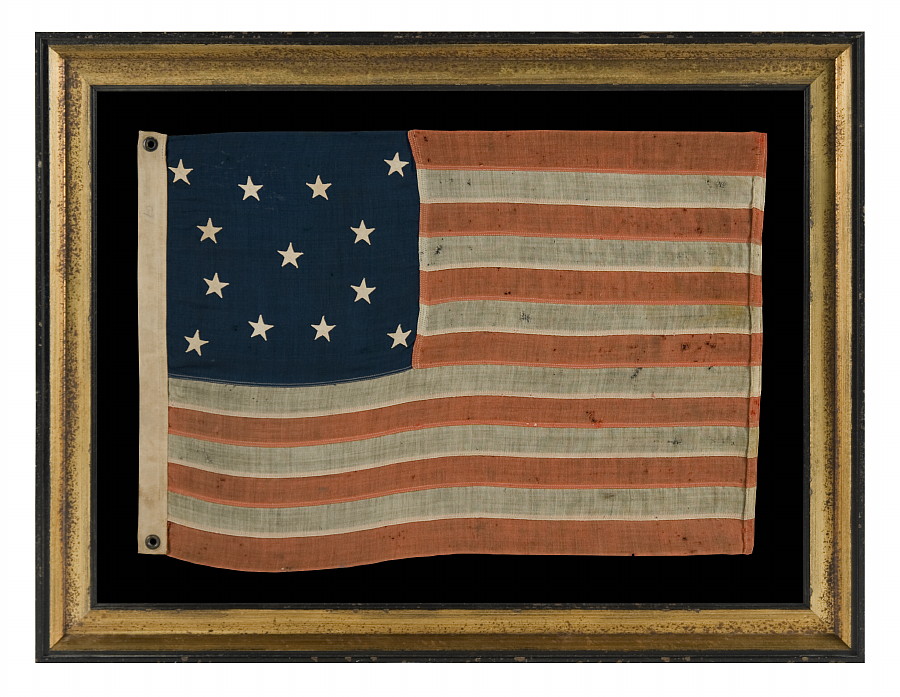
| |
13 STARS IN A MEDALLION CONFIGURATION ON A SMALL-SCALE FLAG OF THE 1890-1910 ERA |
|
| Available: |
Sold |
| Frame Size (H x L): |
35" x 45.25" |
| Flag Size (H x L): |
24" x 34.5" |
|
| Description....: |
|
13 STARS IN A MEDALLION CONFIGURATION ON A SMALL-SCALE FLAG OF THE 1890-1910 ERA:
13 star flag of the type made from roughly the last decade of the 19th century through the first quarter of the 20th century. The stars are arranged in a beautiful medallion configuration, with a single, center star and four flanking corner stars. Most 13-star, flags of this period have a less-desirable, staggered row design with stars arranged in counts of 3-2-3-2-3. Medallion patterns, like this one, seem to comprise about 25% of such flags that were produced in this era.
On this particular flag, the stars are curiously small in scale in proportion to the size of the flag, which adds an interesting element to its visual appearance. A bit more crude than the typical example, the flag has a nice, early, and somewhat more whimsical presentation than others of its kind. These features suggest that is among the earliest examples of small 13 star flags of this general form and construction, which were popular between 1890 and the 1920's. This particular flag was probably made in the 15-year time frame between 1895 and 1910.
Most of these little flags measured approximately 2 x 3 feet, like this flag, or 2.5 x 4 feet. Their small size is significant, because with exception of military flank markers and camp colors, they were far smaller than almost any other type of Stars & Stripes flag with pieced-and-sewn construction that was being produced during this era (and prior). Their small size also makes them desirable, because they are easy to frame and display in an indoor setting. That isn't true of flags with the full compliment of 45 or 46 stars (1896-1912) or even of 48 star flags made before 1930.
Why 13 Stars? The U.S. Navy had long been using 13 stars on its small-scale flags because they wished the stars to be easily discerned at a distance. This was the original number of stars on the American flag and equal to the number of original colonies. As the number of stars grew with the addition of new states, two circumstances occurred. One, it became more and more difficult to fit stars on a small flag and two, it became more and more difficult to view them from afar as individual objects on a small flag.
For all practical purposes, commercial flag-makers simply didn't produce flags with pieced-and-sewn construction that were 3 to 4 feet in length before the 1890's. There are rare exceptions to this rule, but until this time, the smallest sewn flags were approximately 6 feet on the fly. The primary use had long been more utilitarian than decorative, and flags needed to be large to be effective as signals. But private use grew with the passage of time, which led to the need for long-term use flags of more manageable scale.
Beginning around 1890, flag-makers began to produce small flags for the first time in large quantities. Applying the same logic as the U.S. Navy, they chose the 13 star count rather than the full compliment of stars for sake of ease and visibility. Any flag that has previously been official, remains so according to the flag acts, so 13 star flags were and still are official today.
13 star flags have been used throughout our Nation's history for a variety of purposes. In addition to their use on the small scale flags of the 1890-1920's era, the U.S. Navy used the 13 star count on small boats, both in the 18th century and through most or all of the 19th century, particularly the second half. The Navy's use of the 13 star flag ended in 1916 following an executive order written by President Woodrow Wilson. Among other uses, 13 star flags were carried by soldiers during the Mexican and Civil Wars, used at patriotic events, including Lafayette's visit in 1825-26, celebration of the Nation's centennial in 1876 and the sesquicentennial in 1926.
Construction: The canton and stripes of the flag are made of wool bunting, pieced with a treadle machine. The cotton stars are machine-sewn with a zigzag stitch and double-appliqued (applied to both sides of the flag). The zigzag stitch was first patented for use on flags in 1892, but it didn't see widespread use until around 1896. There is a twill cotton sleeve with 2 brass grommets.
Mounting: The flag has been stitched to 100% silk organza on every seam and throughout the star field for support. Then flag was then hand-sewn to background of 100% cotton twill, black in color, which was washed to reduce excess dye. An acid-free agent was added to the wash to further set the dye and the fabric was heat-treated for the same purpose. The flag was then placed in a black-painted and hand-gilded, contemporary Italian molding. The glazing is U.V. protective acrylic.
Condition: There are a couple of very minor holes. There are minor white stains or paint transfer in the canton, possibly from where the flag rubbed up against something white. It presents very well, so nothing was done to adjust it. There is minor fading. many of my clients prefer early flags to show their age and history of use. |
|
|
|
| Collector Level: |
Beginners and Holiday Gift Giving |
|
| Flag Type: |
Sewn flag |
|
| Star Count: |
13 |
|
| Earliest Date of Origin: |
1890 |
|
| Latest Date of Origin: |
1910 |
|
| State/Affiliation: |
13 Original Colonies |
|
| War Association: |
|
|
| Price: |
SOLD |
|
| |
Views: 3767 |
|
|
|

